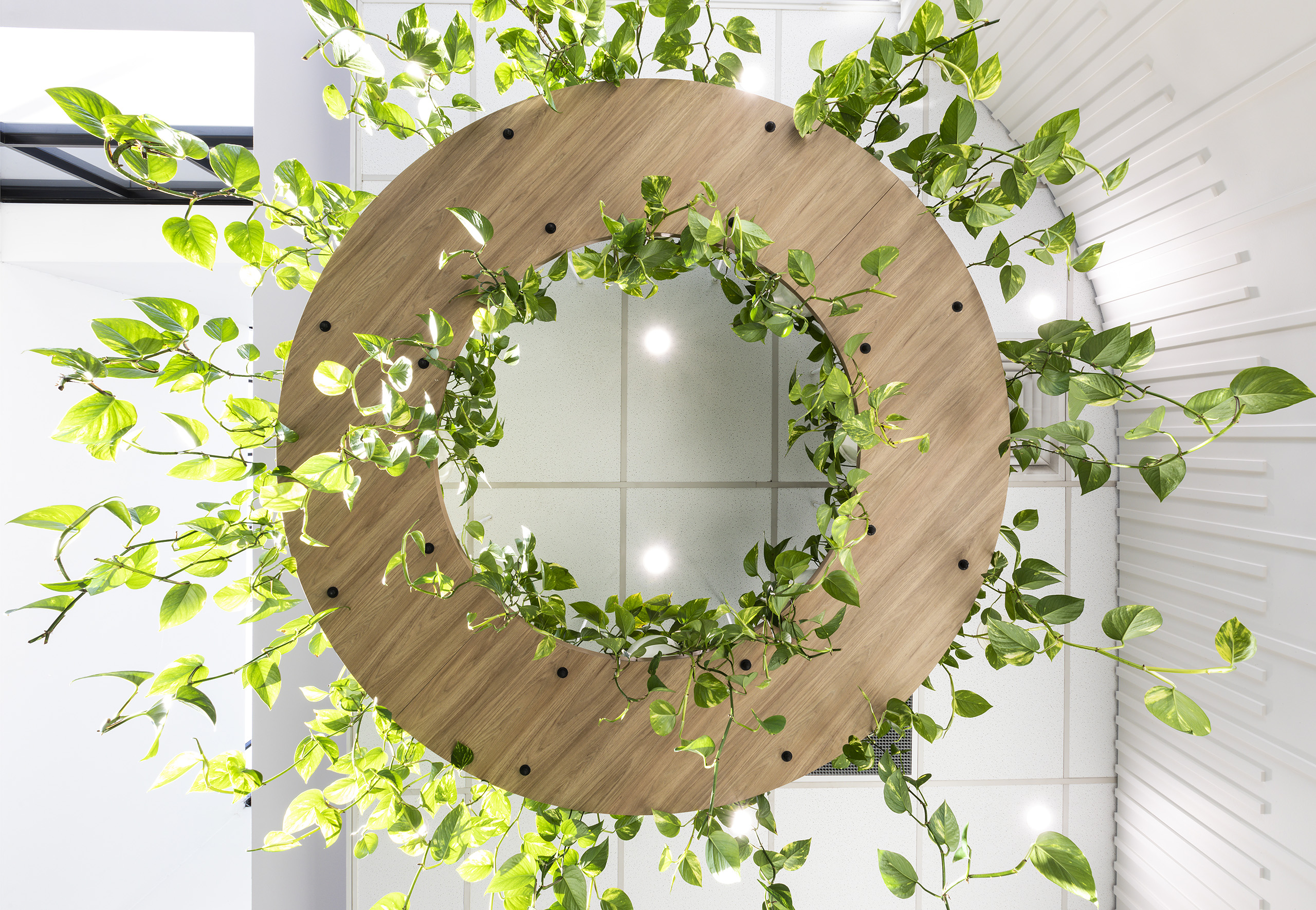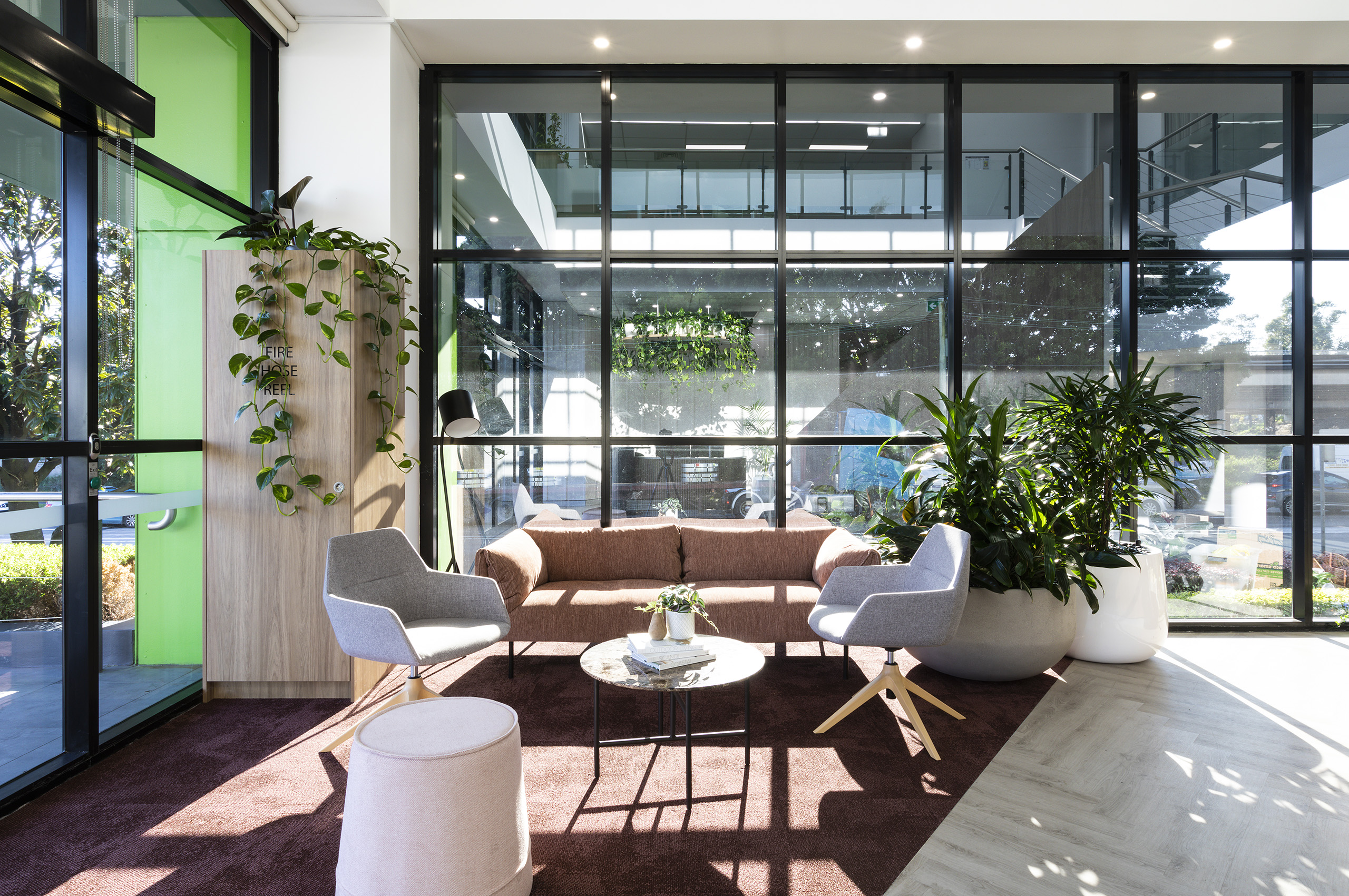We have been curious to find out which elements of office design people think are the most important when it comes to improving well-being in the workplace. So, we asked the question by conducting a recent LinkedIn poll. The results were interesting.
- 14% spaces for social interaction
- 14% quiet zones for focus
- 7% comfortable furniture
- 64% natural light & outdoor access
The winners were natural light and outdoor access. So, why do we crave the presence of nature at work? The answer is simple. Natural surroundings in a workplace help to evoke a sense of serenity, enabling us to feel more calm, comfortable and productive. Incorporating natural aesthetics into your office design is known as Biophilia, an interior design strategy that brings nature's essence indoors to create harmonious, engaging spaces. This approach is important for wellbeing, as incorporating natural elements like greenery, sunlight, and natural materials can significantly reduce stress, boost mood, and improve overall health.
In commercial workplaces, biophilic design can transform a typical workspace into an inspiring environment where employees thrive. Imagine working in a space with large windows that flood the room with natural light, green walls adorned with lush plants, and furniture crafted from warm, natural materials. These elements certainly enhance the visual appeal and promote a sense of calm and productivity.
In this article, we’re diving into why bringing biophilia into your office design is important and how you can easily weave it into your commercial workspace.

Work greener: The case for biophilic design in the workplace
Reduces stress:
Biophilic design creates a calming environment, which can help mitigate the pressures of a high-stress workday and reduce anxiety levels. For example, in a study that tested participants’ responses to stress in different office settings, the office with multisensory biophilic elements was shown to have the best impact on improving participants’ anxiety levels.
Improves cognitive function:
A report by Human Spaces found that biophilic design can improve cognitive function and employee performance. Exposure to natural environments can enhance cognitive focus, helping to improve concentration and memory.
Boosts creativity:
Natural settings have been linked to increased creativity and problem-solving abilities. A workspace that mimics natural landscapes can inspire innovative thinking. The report by Human Spaces found that biophilic design can improve productivity by 6% and creativity by up to 15%.
Improves air quality:
Poor air quality in an office can make it difficult for workers to focus and can lead to mental health issues like anxiety and depression. Including plants in the office can help to reduce these risks. Plants naturally filter out pollutants and increase oxygen levels, which helps to improve air quality. Studies suggest that the presence of indoor plants can enhance cognitive function by up to 15% and reduce feelings of stress.
Improves energy levels:
Exposure to natural light during the day can significantly boost energy levels and reduce feelings of fatigue. Studies have shown that individuals who spend more time in natural light experience higher energy levels and improved mood.
Natural light also plays a crucial role in regulating the body's circadian rhythm, which governs the sleep-wake cycle. A well-regulated circadian rhythm contributes to better sleep quality, ensuring you fall asleep faster and enjoy more restorative rest. Research indicates that people exposed to natural light during the day experience up to 50% better sleep quality.
Encourages physical activity:
Biophilic design encourages physical activity by integrating natural elements into the built environment, which makes spaces more inviting and engaging. Features like accessible green spaces, nature-inspired pathways, and visual cues like large windows with natural views motivate people to move and explore.
Incorporating standing desks or areas for light exercise supports a more active lifestyle. By enhancing the connection between indoor spaces and nature, the biophilic design creates an environment where movement is encouraged and natural activity is seamlessly integrated into daily routines.
Improves visual comfort:
Inadequate lighting in a workspace and prolonged use of computer screens can increase the chances of workers experiencing visual discomfort. Increasing the amount of natural light entering the space can help. For example, a study found that 84% of workers who sat within three metres of a window were more productive and suffered less from headaches, blurred vision, and eyestrain.

Creating a biophilic workplace
Now that you know all the benefits of biophilic office design, you may be wondering how to incorporate this into your workplace. While you can start by simply incorporating natural elements like greenery, we recommend starting with a comprehensive review of your workplace to truly transform your office space. Crest can help you seamlessly integrate biophilia into your office design to enhance your employees’ well-being.
Incorporate greenery:
Place a variety of indoor plants throughout the office to create a vibrant and refreshing environment. For example, you could install living walls or vertical gardens to maximise green space without taking up floor space. Consider low-maintenance options like succulents and air-purifying plants. Another option is to work with plant hire businesses that can provide plants and support the upkeep and maintenance of living greenery in your office.
If you’d rather avoid the maintenance of natural plants, then you can try artificial ones. Although artificial plants won’t be able to filter the air like natural plants, they can still have benefits. Research has found that in terms of wellbeing benefits such as improving mood and morale, as well as productivity and focus, artificial plants really work.
Maximise natural light:
Enhancing your office’s natural light can be straightforward with clever design choices. Start by reconfiguring your layout to ensure that tall furniture doesn't obstruct the light from your windows. Position desks closer to windows and consider removing dividing walls to create a more open, light-filled space. Reserve areas with less natural light, like quiet zones and meeting rooms, for spaces where people spend shorter periods of time.
Enhance outdoor spaces:
Take a look at the outdoor spaces your office might have, like rooftops, balconies, or nearby parks. If you’ve got a rooftop, why not turn it into a garden and relaxation area? It’s a great place for employees to unwind and get fresh air. For courtyards or balconies, ensure plenty of comfortable seating and greenery to encourage people to step outside and enjoy a little nature during their day.
Use natural materials:
Incorporate natural materials like wood and stone into your office design to bring a touch of the outdoors inside. Whether it’s flooring, furniture, or accent walls, these materials can create a warm, organic feel that makes the space more inviting.
Create flexible workspaces:
Design workspaces that give employees the freedom to choose where and how they work best. Flexibility is key, whether it’s a quiet corner with a view of nature or a collaborative area filled with natural light. Using mobile furniture and modular designs lets you adapt the space to different needs and preferences, making it easy for everyone to find their perfect spot.
Final thoughts
If you’re aiming to enhance your team’s wellbeing, a modern biophilic office design is definitely worth considering. As we’ve discussed, it not only supports mental and physical health but also boosts performance, helping your business flourish.
At Crest Interiors, we’re experts in creating workspaces that inspire productivity and well-being. By seamlessly integrating natural elements into your office environment, we ensure your space is inviting and fosters a positive work culture. Reach out to us today and explore how we can transform your workplace.


